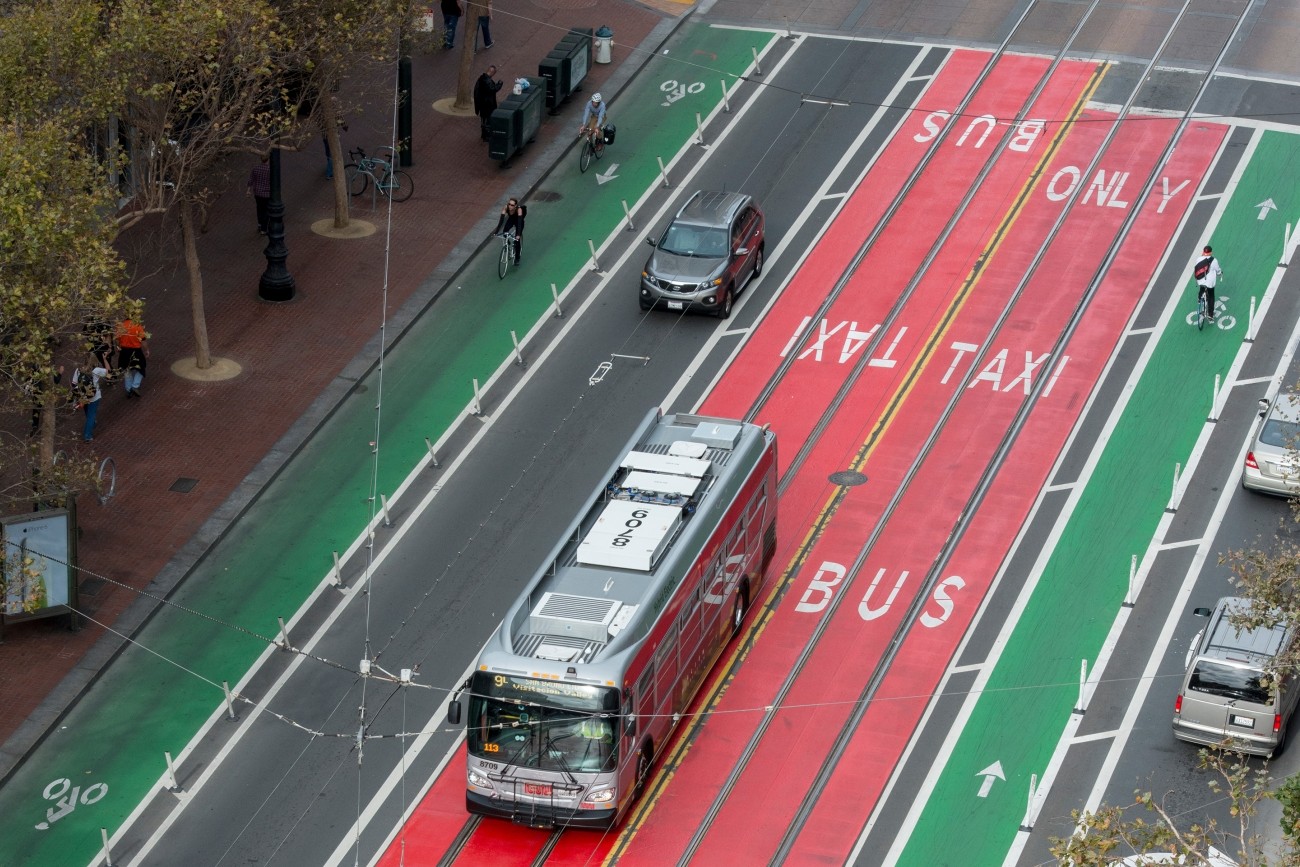Introduction
The Van Ness Improvement Project resulted in San Francisco's first Bus Rapid Transit system. Project improvements include bus-only lanes, rapid bus service, signal prioritization for buses, and a suite of safety improvements such as sidewalk extensions, high-visibility crosswalks, audible countdown signals, and more. To maximize the benefits of construction, the City replaced major utilities including water, sewer, and emergency firefighting water systems.
Resources
SFMTA convened a Citizens Advisory Committee to guide decisions related to the design, construction, and implementation of the project, with meetings open to the public. Visit the SFMTA's project page for project and committee meeting information.
Project Partners
The Transportation Authority led this project through the feasibility and environmental review phases. The project received environmental approvals in 2013 from the Transportation Authority Board, the SFMTA Board, and the Federal Transit Administration, and project traffic approval in 2014 from Caltrans. Since then, SFMTA has managed project implementation and construction.
With over $38 million of half-cent sales tax funds supporting the project, the Transportation Authority continued to provide project support and oversight to ensure environmental compliance and implementation.
Timeline & Status
Construction began in October 2016. Service began April 2022.
Cost & Funding
The Bus Rapid Transit project was part of a larger Van Ness Improvement Project totaling $346 million. The overall project combines the bus rapid transit project with several infrastructure upgrade projects, including installation of new overhead trolley contacts, traffic signal replacements, sewer and water improvements, and street lights.
Contact
SFMTA: vannessbrt@sfmta.com
The Van Ness Avenue Bus Rapid Transit project will create dedicated bus lanes along two miles of Van Ness and South Van Ness Avenues, from Lombard to Mission streets. The lanes will be used by Muni’s 49 and 47 Muni routes and Golden Gate Transit. The transit-only lanes will run along center landscaped medians down Van Ness Avenue, physically separated from the two lanes of mixed flow traffic in each direction. All-door boarding, elimination of most left turns, transit signal priority, and traffic signal optimization will help reduce transit travel time on the corridor by up to a third. In addition, pedestrian improvements, signal upgrades, new streetlights, new landscaping, and roadway resurfacing will be implemented to improve safety and aesthetics.
One of the main features of a Bus Rapid Transit system is dedicated bus lanes, which get buses out of congested traffic and reduce delays. New boarding platforms are another part of a Bus Rapid Transit system and make it safer and easier to get on and off the bus. Other features that keep the buses moving, like stop changes and traffic signal adjustments, can save riders even more time.
Van Ness Bus Rapid Transit is a signature project of the Transportation Authority’s Prop K transportation sales tax program and is the culmination of years of multi-agency collaboration at the local, state, and federal levels to improve transit along this part of U.S. Highway 101.
The Transportation Authority led this project through the feasibility and environmental review phases. The project received environmental approvals in 2013 from the Transportation Authority Board, the SFMTA Board, and the Federal Transit Administration, and project traffic approval in 2014 from Caltrans. Since then, SFMTA has managed project implementation and construction. Construction began in October 2016. With over $36 million of Prop K half-cent sales tax funds supporting the project, the Transportation Authority continues to provide project support and oversight to ensure environmental compliance and efficient implementation.
The Transportation Authority led the Van Ness Avenue Bus Rapid Transit Project, in partnership with the SFMTA and the Federal Transit Administration, through the completion of environmental review, marked by the issuance of a Record of Decision by the Federal Transit Administration on December 20, 2013.
Key Documents
Final Environmental Impact Report, 2013, Volume I (PDF) and Volume II (PDF)
Addendum to the Final Environmental Impact Report, 2016 (PDF)
Van Ness BRT Feasibility Study, 2006 (PDF)
Federal Transit Administration Record of Decision, 2013 (PDF)
Notices/Approvals
Transportation Authority Notice of Determination
SFMTA Notice of Determination
Final EIS/EIR Notice of Availability
EIR Notice of Intent
EIR Notice of Preparation
Final Environmental Impact Report Chapters
Volume I
Cover, Signature Page, Preface, and Executive Summary (1MB)
Table of Contents and Acronym List (112KB)
Chapter 1: Project Purpose and Need (1MB)
Chapter 2: Project Alternatives (2MB)
Chapter 3: Transportation Analysis (3MB)
Chapter 4: Affected Environment, Environmental Consequences, and Avoidance, Minimization, and/or Mitigation Measures (19 MB)
Chapter 5: Cumulative Impacts (1MB)
Chapter 6: Draft Section 4(f) Analysis (265KB)
Chapter 7: California Environmental Quality Act Evaluation (348KB)
Chapter 8: Coordination and Public Participation (177KB)
Chapter 9: Financial Analysis (1MB)
Chapter 10: Alternatives Analysis and LPA (705KB)
Chapter 11: References (65KB)
Appendix A: Alignment Plans (15MB)
Appendices B–H (39MB)
Volume II
Appendix I: Cover, Introduction, and Master Responses (1MB)
Appendix I: Agency Comments and Responses (25MB)
Appendix I: Individuals' Comments and Responses (12MB)
Appendix I: Organization Comments and Responses (6MB)
Appendix J: Mitigation Monitoring and Reporting Plan (1MB)
Technical Memos
Tree Removal and Planting Opportunity Evaluation (6MB)
Geologic Impacts Assessment Report (3MB)
Initial Environmental Site Assessment Report (166KB)
Noise and Vibration Study (29MB)
Overhead Contact System (OCS) Support, Poles, and Streetlights Conceptual Engineering Report (14MB)
Visual Impact Assessment Memo (6MB)
Natural Resources Technical Memo (1MB)
Van Ness BRT Feasibility Study (5MB)|BRT Design Criteria Memo (169KB)
Storm Water Data Report (390KB)
Air Quality Technical Report:
- Air Quality Impact Report (691KB)
- Air Quality Impact Report Addendum (391KB)
Cultural Resources Reports:
- Finding of Effect (37MB)
- Historic Property Survey (230KB)
- Historic Resources Evaluation and Inventory Report:
- State Historic Preservation Officer Letters:
- Continuing Section 106 Consultation
Transportation and Traffic:
- Vehicular Traffic Analysis Technical Memo (2MB)
- Vehicular Traffic Analysis Technical Appendices (26MB)
Water Quality Technical Report (2MB)
Non-Motorized Transportation Impacts (4MB)
